-Wiener Aktionismus: Zitate/The Cult of Cruelty (Quotes)
Violence as Art & Art as Violence*
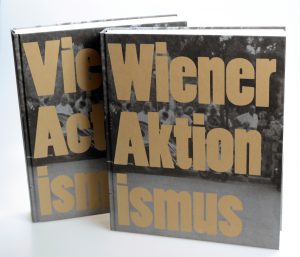 In art and literature it becomes more and more difficult to separate the sheep from the goats, in other words: valid artists from charlatans. It’s all a matter of opinion. (In my humble opinion, the goats gained the upper hand long ago, and their bleating is the dominant sound.) However, public “Actions” such as the flagellation of self and others, the drinking of blood and urine, the eating of feces, copulation to the accompaniment of fecal production, self-mutilation, self-immolation and tormenting animals to death are actions that I for one could not keep silent about. Examples: Valie Export poured scalding wax over live birds. Günter Brus slit his chest open with a razor blade and declared that the next step would be to cut a piece of himself off and eat it. Rudolf Schwarzkogler committed suicide in a ritualistic act of self-immolation. It is alleged that he cut his penis off before defenestrating himself.
In art and literature it becomes more and more difficult to separate the sheep from the goats, in other words: valid artists from charlatans. It’s all a matter of opinion. (In my humble opinion, the goats gained the upper hand long ago, and their bleating is the dominant sound.) However, public “Actions” such as the flagellation of self and others, the drinking of blood and urine, the eating of feces, copulation to the accompaniment of fecal production, self-mutilation, self-immolation and tormenting animals to death are actions that I for one could not keep silent about. Examples: Valie Export poured scalding wax over live birds. Günter Brus slit his chest open with a razor blade and declared that the next step would be to cut a piece of himself off and eat it. Rudolf Schwarzkogler committed suicide in a ritualistic act of self-immolation. It is alleged that he cut his penis off before defenestrating himself.
Such excrescences are engaged in and supported by the Austrian cultural elite, la crème de la crème. They meet the approval of the powers-that-be, as well as those aspiring to power. The advocates are skillful and well-versed in the art of sophistry and have become an integral part of the anti-fascist scene.
*from "Violence Under the Guise of Art" or "Third Reich Recycling" by Herbert Kuhner
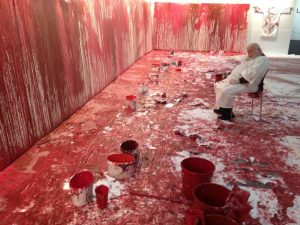
nitsch im blutrausch/blood rage?
The Cult of Cruelty (Quotes)
“A bird is tied to a pedestal with a thin cord. I kneel in front of the bird on the pedestal and then I pour scalding wax over it. When I knock the pot of wax over with my head the bird’s head is inundated and my right hand is doused.” [34]
– Valie Export, Actionist & designer of the anti-fascistic monument in Allentsteig, Lower Austria
“One of the women, who is now 29 years old, describes how Mühl forced her to engage in sexual actions with him in front of the leadership of the commune at the age of five. Both women state that at the time of Mühl’s trial, they were forced to remain silent about these occurrences by members of the Commune.” [35]
– Der Spiegel, March 1, 2004
“But if you observe him now, you see the members of the group who remained with him. I would like to be a part of it; they are having fun…something’s really happening there…. I saw that the women were happy ….I am the patron of an organization against sexual abuse (Power4me).[36]
– Dagmar Koller, musical comedy star, concerning Otto Mühl
“Mühl’s specialty is minors and sex, and my specialty is the agonizing torture of animals.…I could well envision that murder could be a component of a work of art.[37] Killing was and is beyond all moral judgments. [38]
– Hermann Nitsch, Actionist
“Nitsch is a sadist with a mania for approbation, an autistic alcoholic who’s completely narcissistic and a mother’s boy who didn’t get enough attention. Rainer is genuinely violent and a sadist. Nitsch torments the participants in his actions; they’re constantly freezing. He arranges that intentionally. I’d like to know how many became ill, how many caught pneumonia, how many died.”[39]
– Otto Mühl, Actionist
“Nitsch, who never slaughtered an animal in his life, is constantly referred to as a slaughterer.”
– Profil magazine[40]
“Nitsch is the greatest animal lover I know. I was present in the Nitsch household at his home when his swatted a mosquito and caused a major marital crisis. Nitsch gave vent to his anger over the senseless death of this living thing.” [41]
– Danielle Spera, Museum Curator
“The intoxication created by the blood and the ripping apart of raw flesh should be satisfying and enjoyable since it relieves man of his suppressed desires…. If possible I would prefer to work with human beings, with dead human beings, with corpses to be specific.”[42]I could well envision that murder could be a component of a work of art; the artist’s accountability would have another status…Thus, art can consist of a crime.”[43] Killing was and is beyond all moral judgments.”[44]
– Hermann Nitsch
Headlines, April 2015: „NÖN“, „Heute“
°emphasis of my Actions is not on animals.”
“Nitsch is considering blood orgies by using human cadavers.” www.heute.at
“I could very well imagine using human cadavers in my actions,” the artist is quoted by NÖN.“
“The Artist Drank Blood, I have no Money“, Hermann Nitsch
see also: „Third Reich Recycling“ (the secret manuscript) here
Lutz Dammbeck: “In other words, in the cultural scene one can give vent to Nazi-type barbarity under a Leftist banner.” (click here)
Lutz Dammbeck (Filmemacher) in „Das Meisterspiel“: „Das heißt also, in der Kunstszene kann man unter linken Etiketten mal so richtig die Nazi-Sau ʼrauslassen.“ (klick hier)
Excerpt from Fritz Kleibels Film „Enroute with Herbert Kuhner“ 52 Min. 2014
Zitate:
„Mühl ist spezialisiert auf Minderjährige und Sex, und ich bin spezialisiert auf qualvolles Martern von Viechern … Ich könnte mir vorstellen, daß ein Mord durchaus Bestandteil eines Kunstwerks ist. [7] Das Töten war und ist außerhalb des ethischen Urteils.“ [8]
– Hermann Nitsch, Aktionist
„Eine der Frauen, heute 29, sagt etwa aus, sie habe als Fünfjährige, umringt von der Führungsmannschaft der Kommune, Mühl sexuell befriedigen müssen.
Die beiden nun gegen Mühl auftretenden Frauen sagen, sie seien zur Zeit der Gerichtsverhandlung gegen Mühl von Ex-Kommunarden gezwungen worden, nicht über die Geschehnisse zu reden.“ [9]
– Der Spiegel, 1. März 2004
„Aber wenn man ihn jetzt beobachtet, sieht man ja diese Gruppe, die ist dageblieben, da möchte ich auch dabei sein, die sind lustig … da entsteht was bei ihnen … Ich habe erfahren, daß die Frauen glücklich waren … ich bin in einem Verein gegen sexuellen Mißbrauch als Schirmherrin (Power4me). Ich bin gegen sexuellen Mißbrauch und kämpfe gegen das.“[10]
– Dagmar Koller betreffend die Otto Mühl Kommune
„Die Berauschung durch Blut und das Auseinanderreißen von rohem Fleisch soll befriedigend sein … Das Töten war und ist außerhalb des ethischen Urteils.[11] Wenn es möglich wäre, würde ich durchaus lieber mit Menschen arbeiten, mit toten Menschen, nämlich mit Leichen.[12] Ich könnte mir vorstellen, daß ein Mord durchaus Bestandteil eines Kunstwerks ist, daß aber jetzt eine andere Verantwortungsebene an den Mörder herantritt.… Also: Kunst kann auch ein Verbrechen sein, sagen wir es so.“[13]
– Hermann Nitsch
Nitsch ist der größte Tierfreund, den ich kenne. Eine schwere Ehekrise im Haus Nitsch, bei der ich anwesend war, entstand über eine Gelse, die von seiner Frau erschlagen worden war. Nitsch ließ seien m Ärger über den sinnlosen Tod eine Lebewesens freien Lauf.“[14]
– Danielle Spera, Musemsdirektorin
„Auf einem wird ein Vogel mit dünnen Schnüren befestigt.Ich knie vor dem Vogel auf dem Podest und übergieße ihn mit flüssigem, heißem Wachs, dann übergieße ich meine Füße und meine linke Hand mit Wachs.“ [19]
– Valie Export, Aktionistin, Gestalterin des antifaschistisches Mahnmals, Allentsteig, N.Ö.
„Mühl ist spezialisiert auf Minderjährige und Sex, und ich bin spezialisiert auf qualvolles Martern von Viechern … Ich könnte mir vorstellen, daß ein Mord durchaus Bestandteil eines Kunstwerks ist. [21] Das Töten war und ist außerhalb des ethischen Urteils.“ [22]
– Hermann Nitsch, Aktionist
„Eine der Frauen, heute 29, sagt etwa aus, sie habe als Fünfjährige, umringt von der Führungsmannschaft der Kommune, Mühl sexuell befriedigen müssen. Die beiden nun gegen Mühl auftretenden Frauen sagen, sie seien zur Zeit der Gerichtsverhandlung gegen Mühl von Ex-Kommunarden gezwungen worden, nicht über die Geschehnisse zu reden.“ [23]
– Der Spiegel, 1. März 2004
„Aber wenn man ihn jetzt beobachtet, sieht man ja diese Gruppe, die ist dageblieben, da möchte ich auch dabei sein, die sind lustig … da entsteht was bei ihnen … Ich habe erfahren, daß die Frauen glücklich waren … ich bin in einem Verein gegen sexuellen Mißbrauch als Schirmherrin (Power4me). Ich bin gegen sexuellen Mißbrauch und kämpfe gegen das.“[24]
– Dagmar Koller betreffend die Otto Mühl Kommune
- Überschriften, April 2015: „NÖN“, „Heute“:
„Die Betonung meiner Aktionen liegt nicht bei den Tieren“.
„Nitsch überlegt Blut-Orgie mit menschlichen Leichen | www.heute.at
„Ich könnte mir durchaus vorstellen, mit menschlichen Leichen Aktionen zu machen“, zitiert „NÖN“ den Herrn Nitsch.
„Künstler trank Blut: Hermann Nitsch: „Ich habe kein Geld“
Padhi Frieberger: „Die Nazis haben versucht, die Kunst von außen zu zerstören. Die jetzigen Zerstörer haben sich alles unter den Nagel gerissen und zerstören die Kunst von innen.“
Padhi makes comparisons: “The Nazis attempted to destroy art from the outside. Those who practice destruction today have taken over on the inside and destroy art from within.”
Wer hat das letzte Wort?!
* * *
[7] Falter 24-30. 7, Nr. 30, 1998, S. 18.
[8] Gerhard Jaschke: Das rote Tuch, aus Paula Devarney: „Nitsch: Art of Killing“, Caellian, 9. Okt. 1970.
[9] Jürgen Kremb: „Opfer der Kommine“, Der Spiegel, Nr. 10, 1. März 2004, S. 156.
[10] Barbara Stöckl, ORF 11.04.2013, 23:00 Uhr.
[11] Gerhard Jaschke: Das rote Tuch, aus Paula Devarney: „Nitsch: Art of Killing“, Caellian, 9. Okt. 1970.
[12] Mojca Kumerdej: „Hermann Nitsch o smrti in ziviljenju“, Delo, 3. Okt. 1992, Ljubljana; ”Im Blutrausch”, News, Nr.30/95,S.190; Sechs Tage blutiges Welttheater, News, Nr.40/96, S.190; The Devil In a Grey Beard, Interview mit Adrian Searle, The Guardian, 15. Nov. 1997, S. 17; News, Nr. 27, 5. Juli 2001, S. 7.
[13] Falter 24-30. 7, Nr. 30, 1998, S. 18.
[14] Danielle Spera: Hermann Nitsch. Leben und Arbeit, Brandstätter, Wien, 2002, S. 9.
[19] performance-art-research.de/AndereTexte.htm; Beschreibung von Valie Export in: http://www.urban-infill.com/asemie2.htm, 20.02.2004.
[20] Andreas Schlothauer: Die Diktatur der freien Sexualität, S. 122.
[21] Falter 24-30. 7, Nr. 30, 1998, S. 18.
[22] Gerhard Jaschke: Das rote Tuch, aus Paula Devarney: „Nitsch: Art of Killing“, Caellian, 9. Okt. 1970.
[23] Jürgen Kremb: „Opfer der Kommine“, Der Spiegel, Nr. 10, 1. März 2004, S. 156.
[24] Barbara Stöckl, ORF 11.04.2013, 23:00 Uhr.
[25] Danielle Spera: Hermann Nitsch. Leben und Arbeit, Brandstätter, Wien, 2002, S. 9.
[26] Gerhard Jaschke: Das rote Tuch, aus Paula Devarney: „Nitsch: Art of Killing“, Caellian, 9. Okt. 1970.
[27] Mojca Kumerdej: „Hermann Nitsch o smrti in ziviljenju“, Delo, 3. Okt. 1992, Ljubljana; ”Im Blutrausch”, News, Nr.30/95,S.190; Sechs Tage blutiges Welttheater, News, Nr.40/96, S.190; The Devil In a Grey Beard, Interview mit Adrian Searle, The Guardian, 15. Nov. 1997, S. 17; News, Nr. 27, 5. Juli 2001, S. 7.
[28] Falter 24-30. 7, Nr. 30, 1998, S. 18.
[34] performance-art-research.de/AndereTexte.htm; Beschreibung von VALIE EXPORT in: http://www.urban-infill.com/asemie2.htm, 20.02.2004.
[35] Jürgen Kremb: „Opfer der Kommune“ Der Spiegel, No. 10, March 1, 2004, p. 156.
[36] Barbara Stöckl, ORF (Austrian TV), April 11, 2013, 11 p.m.
[37] Falter 24-30, 7, No. 30, 1998, p. 18.
[38] Paula Devarney: “Nitsch – Art of Killing,” Caellian, 9. Oct. 1970; Hermann Nitsch: Das rote Tuch – Das Orgien Mysterien Theater – Im Spiegel der Presse 1960-1988, Freibord, Vienna, 1988, p. 106.
[39] Andreas Schlothauer, Die Diktatur der freien Sexualität p. 122.
[40] Gerhard Jaschke, Ed.: Reizwort Nitsch, Sonderzahl, Vienna, 1995, S. 20, “Einen Spaß,” from Profil, Sept. 1988.
[41] Danielle Spera: Hermann Nitsch. Leben und Arbeit, Brandstätter, Vienna 2002. p. 9.
[42] Mojca Kumerdej: “Hermann Nitsch o smrti in Zivljenu,” Delo, Ljubljana, Oct. 3, 1992; “Im Blutrausch,” News,, No. 30/95, p. 190; “Sechs Tage blutiges Welttheater,” News, No. 40/96, p. 190, “The Devil In a Grey Beard,” interview with Adrian Searle, The Guardian, Manchester, Nov. 15, 1997, p. 17; News, No. 27, July, 2001, p. 7.
[43] Falter 24-30, 7, No. 30, 1998, p. 18.
[44] Paula Devarney: “Nitsch – Art of Killing,” Caellian, 9.
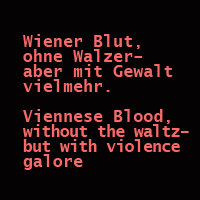
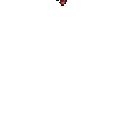
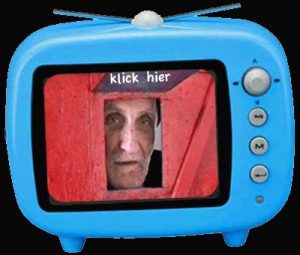








 Users Today : 6
Users Today : 6 Users Yesterday : 18
Users Yesterday : 18 This Month : 842
This Month : 842 This Year : 2824
This Year : 2824 Total Users : 80404
Total Users : 80404 Views Today : 7
Views Today : 7 Total views : 242466
Total views : 242466 Who's Online : 1
Who's Online : 1